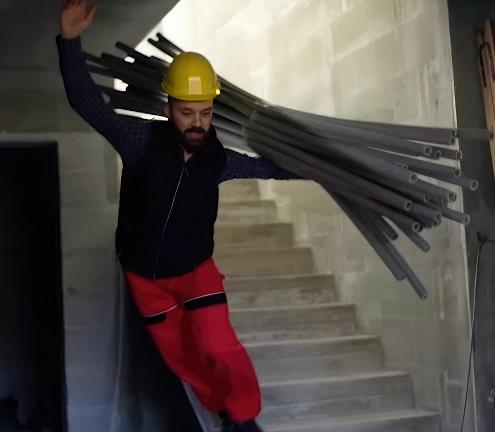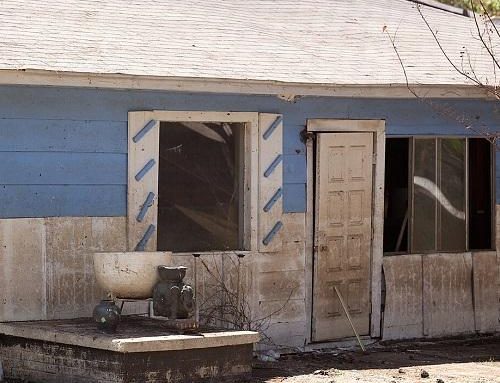Introduction
Construction consistently ranks as one of the most dangerous industries, and falls are a leading cause of serious and fatal injuries. Falls can and do happen on level ground, but working at heights multiplies the risks. From ladders and scaffolds to rooftops and fixed ladders, hazards lurk everywhere. No matter your role, proper training and diligent compliance with safety guidelines is mandatory. This article, excerpted from the online training course “Fall Protection in Construction Environments,” will cover the essentials of recognizing hazards, using appropriate safety gear, and implementing safety systems to prevent falls. With knowledge and preparation, worksites can be made safer for everyone.
Surprisingly Easy Falls Can Cause Serious Harm
Construction workers take on tough challenges daily, but something as simple as walking can lead to disaster. Slips, trips and falls cause almost 20% of disabling workplace injuries, resulting in thousands of fatalities annually. And it doesn’t take a long drop to get seriously hurt—losing balance from a standing position can result in broken bones or head trauma. But implementing safety practices can prevent these needless accidents.
Proper Footwear Helps Avoid Slips and Trips
Choosing appropriate footwear is the first step in slip and fall prevention. Leather soles are prone to slipping, while open-toed shoes easily catch on objects. High heels lack stability. The best shoes have rubber soles for grip and deep treads for traction in mud or water. Additionally, be vigilant in identifying slippery surfaces like polished marble, wet vinyl, and oily patches which require extra caution. Keep floors clear of clutter that causes trips and clean up spills immediately. Don’t cut corners on safety.
Guardrails, Covers Safeguard Against Falls
Edges and openings in floors and rooftops present major fall hazards. Installing physical barriers called “guarding” can protect workers. Wire mesh over skylights, railings around pits, and covers over holes prevent access to dangerous areas. Guardrails should meet OSHA specifications: top rails at 42 inches high, midrails halfway down, and vertical posts spaced no more than 8 feet apart. Railings must withstand 200 pounds of force. Screens or toe boards that prevent items from rolling off edges provide added protection. Immediately report unguarded hazards to supervisors so safety measures can be implemented. Don’t work around unsecured openings.
Proper Ladder Use Fundamental to Safety
Portable and fixed ladders offer simple, temporary access for working at heights. But gravity makes falls a constant concern. Before climbing, inspect ladders for defects and damage. Tag broken equipment “Do Not Use” and replace immediately. Ensure portable ladders are positioned securely with a proper angle—1 foot out for every 4 feet of height. Extend 3 feet above the top landing. Maintain 3 points of contact when climbing and limit tool carrying. On long, fixed ladders, use safety devices like ladder climbing systems for additional security. Take responsibility for inspection, setup, and safe climbing. Don’t take chances on questionable equipment.
Scaffolding Requires Caution and Planning
Providing elevated and stable work platforms, scaffolds enable labor at heights. But scaffolds are also involved in many injuries and fatalities. Follow standards to control hazards. Use built-in stairs or secure ladders—never climb on scaffold frames. Keep platforms clear of debris that could fall on workers below. Do not stand on objects to extend reach. Ensure proper fall protections like guardrails, safety nets, or personal fall arrest systems are in place. Check the site-specific fall protection plan for required equipment and setup. Improper scaffold use endangers everyone. Stay in compliance with regulations.
Personal Fall Protection Systems for the Highest Hazards
Some jobsite situations, like working on rooftops or long ladders, carry exceptional risk of serious falls. OSHA mandates personal fall protection which includes a body harness, connecting device, and anchorage. Snug harnesses distribute massive forces across the body to prevent injury if activated. Shock-absorbing lanyards and retractable lifelines afford mobility. Anchorages must support 5,000 pounds per worker. Structural members, ladder systems, and lift cages often provide approved anchors. Consult site-specific fall protection plans for proper equipment choices and setup. Don’t tie off on inadequate structures. Wearing required PPE greatly improves safety when working from heights.
With hazard awareness, proper footwear and PPE, safe equipment usage, and by following OSHA fall protection guidelines, construction workers can prevent tragic accidents. No task is too important to justify skipping safety measures. Correct behaviors, inspection, and reporting create a culture of responsibility. The jobsite should never be the last place someone stands—it’s time to put falls behind us.
Stairways Require Careful Use
Most falls on stairs result from risky behavior. Never run or skip steps. Carry items small enough to see over. Keep one hand on the railing whenever possible for stability. Rushed actions or oversized loads lead to slips and tumbles. Make safety the priority on stairs.
Recognize Trip and Fall Hazards
In work zones, “edges” and “openings” pose falling hazards. Catwalks, rooftops, loading docks, and other elevated work platforms represent dangerous edges. Skylights, manholes, stairwells, and ladder access holes qualify as openings. Distracted workers can easily misstep and fall through these unguarded areas. Be vigilant when moving through work sites and use barriers when possible. Don’t let your guard down around unprotected edges and openings.
Report and Repair Safety Hazards
Poor maintenance creates slip and fall hazards. Damaged flooring, torn carpeting, and unchecked leaks cause problems. When you notice deficiencies, either repair them immediately or report them to your supervisor so they can be addressed before an incident occurs. Don’t ignore known hazards. Speak up to prevent injuries.
Avoid Unsafe Practices
Even well-maintained sites contain hazards if workers take unnecessary risks. Shortcuts like using stacked pallets for ad hoc stairs or standing on rolling chairs to reach high shelves often end badly. Always use the right equipment for the job. Working safely requires patience and planning. Don’t court disaster by being careless.
Maintain 3 Points of Contact on Ladders
When climbing ladders, follow the “3-Point Rule” – two hands and one foot, or one hand and two feet should always be touching the ladder. Keep your belt buckle centered between the rails and don’t lean back. The 3-Point Rule prevents slips and loss of balance. Don’t let go and reach for things. Stay stable.
Adjust to Situations Requiring Fall Protection
Fall protection is mandatory when working over 10 feet above ground level on scaffolds. It’s also required when working near unprotected edges, skylights, or wall openings. Personal fall arrest systems, guardrails, and safety nets provide security. But regulations change based on the exact workplace setup. Verify required equipment by checking the governing fall protection plan for each site. Don’t make incorrect assumptions about what PPE is needed.
Inspect, Assemble, and Anchor PFAs Properly
Before use, inspect personal fall arrest system components for damage. Make sure bolts and straps are tight. Review proper arrangement of harnesses, connectors, and lifelines. Verify anchorage locations are approved and capable of bearing required loads. Ask questions if uncertain about equipment or setup. Don’t guess when lives are at stake. Improper use compromises safety.
Conclusion
Construction work involves inherent hazards when performing tasks at height, but implementation of proper safety practices and equipment can prevent tragic occurrences of falls and injuries. By remaining vigilant, following regulations, and refusing to take risky shortcuts, worksites can be made secure. Falls may be an ever-present threat in the building trades, but they are not inevitable. Stay safe by staying informed and being prepared. With your commitment to operating responsibly, construction can be made safer for all.
Bridging to the Next Step: Cultivating a Culture of Safety
This article has shed light on the various hazards and safety practices essential to minimizing the risk of falls in construction environments. But let’s be honest; awareness and understanding are only the first steps. How can you ensure that all these critical safety measures are not just understood but deeply ingrained in your workforce? That’s where dedicated, focused training comes in, transforming individual knowledge into a collective culture of safety.
🔒 Unlock a Culture of Safety with Our Full-Length Interactive Courses on Fall Protection
Imagine a workplace where every step is secure, where every move is a confident one, free from the shackles of doubt and worry about falls. That’s not just a safer environment; it’s a more productive, happier one.
🎯 What’s at Stake?
Workplace falls account for nearly 20% of all disabling occupational injuries and claim thousands of lives every year. You can’t afford to be part of these statistics; neither can your employees.
🛠 How Our Courses Can Help
Our full-length interactive courses dig deep into the complexities of fall protection, providing a comprehensive roadmap for cultivating a culture of safety.
Course Topics Include:
- Preventing Slips, Trips, and Falls: Master the basics and the intricacies of stable footing.
- Edges, Openings, and Guarding: Learn how to fortify vulnerable spots that are accidents waiting to happen.
- Using Portable and Fixed Ladders: Get a firm grip on how to climb the career ladder, literally and metaphorically.
- Working Safely on Scaffolding: Attain peace of mind when you’re high above ground level.
- Personal Fall Protection: Equip yourself and your team with the know-how and the gear to stay safe, always.
Why Choose Us?
- In-depth Material: Our courses aren’t surface-level overviews; they are deep dives into each topic.
- Interactive Learning: Engage with real-world scenarios that test your understanding and decision-making abilities.
- Bilingual: All courses are available in English and Spanish, because safety knows no language barriers.
📥 Act Now Don’t leave safety to chance; make it a certainty. Click the link to view a free demonstration of the course and to download a detailed course outline in PDF format and take the first step toward a workplace where safety is ingrained, not just implemented.
Let’s build a culture of safety together. Secure your team’s future today.










